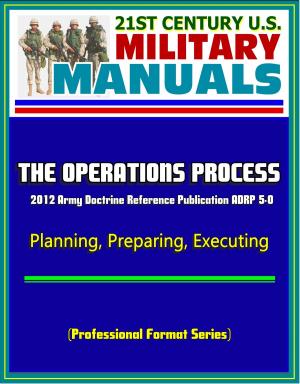21st Century FEMA Study Course: Disaster Basics (IS-292) - FEMA's Role, Emergency Response Teams (ERTs), Stafford Act, History of Federal Assistance Program
Nonfiction, Social & Cultural Studies, Political Science| Author: | Progressive Management | ISBN: | 9781465838070 |
| Publisher: | Progressive Management | Publication: | July 18, 2011 |
| Imprint: | Smashwords Edition | Language: | English |
| Author: | Progressive Management |
| ISBN: | 9781465838070 |
| Publisher: | Progressive Management |
| Publication: | July 18, 2011 |
| Imprint: | Smashwords Edition |
| Language: | English |
This Federal Emergency Management Agency (FEMA) independent training course manual from the Emergency Management Institute (EMI) introduces the student to the basics of disaster assistance and the role of FEMA. Topics covered include the Stafford Act, the history of the Federal Disaster Assistance Program, the Disaster Response Process, FEMA's role in Managing Disasters, Presidential Disaster Declarations, and Emergency Response Teams (ERTs).
Before 1950, there was no comprehensive disaster program. Disaster recovery was funded by Congress on an incident-by-incident basis. In 1950, Congress enacted the initial disaster relief program, Public Law 81-875. Under this law:
Funding was authorized for a disaster relief program rather than a single-incident response. The responsibility for determining when Federal disaster relief is required was transferred from Congress to the President.
The basic philosophy of Federal disaster relief was established—that Federal assistance is supplemental to State and local resources. The basis for later legislation on cost-sharing between Federal and State or local governments was established. Provisions were made for emergency repairs to or temporary replacement of essential public facilities. Aid was provided only to State and local governments. Individuals could rely on the American Red Cross, the Salvation Army, the Mennonite Disaster Service, and other charitable organizations. In April 1974, there was a series of devastating tornadoes that hit six Midwestern States. This event confirmed the need to add assistance to individuals and families to the Disaster Relief Program. As a result, the Disaster Relief Act of 1974 (Public Law 93-288) was established. Under this law:
The Individual and Family Grant Program was established. Federal and State disaster relief operations are conducted on a partnership basis, and a State Coordinating Officer (SCO) works jointly with an FCO. Federal assistance supports local and State activities and resources. Assistance is contingent upon a Presidential declaration. Before 1981, the Public Assistance Program, which provided disaster assistance to State and local governments, was in the form of a 100 percent Federal grant. The response to the eruption of Mount St. Helen’s in May 1980 was the first administrative implementation of a 75 percent Federal and 25 percent State and local cost sharing of disaster expenses. This response was the first step toward a cost-sharing full-partnership concept of managing disaster response and recovery. During the 1980’s, the Senate expressed concern about the use of the disaster authority for responding to non-natural disasters or emergencies such as managing the Cuban refugee influx and Three Mile Island incident. The Three Mile Island incident, as well as a number of perceived deficiencies, stimulated Congress to review disaster programs. Over the next several years, legislation was initiated to change Public Law 93-288. In November 1988, the Robert T. Stafford Disaster Relief and Emergency Assistance Act was passed. This act provided a framework for continued disaster relief. It also legislated a minimum 75 percent Federal/25 percent State and local cost sharing for the public assistance program. The Stafford Act refocused assistance for non-natural disasters, unless caused by fire, flood, or explosion, to a more limited scope. It also confirmed the importance of individual assistance and added an emphasis on mitigation of future losses.
This is a privately authored news service and educational publication of Progressive Management.
This Federal Emergency Management Agency (FEMA) independent training course manual from the Emergency Management Institute (EMI) introduces the student to the basics of disaster assistance and the role of FEMA. Topics covered include the Stafford Act, the history of the Federal Disaster Assistance Program, the Disaster Response Process, FEMA's role in Managing Disasters, Presidential Disaster Declarations, and Emergency Response Teams (ERTs).
Before 1950, there was no comprehensive disaster program. Disaster recovery was funded by Congress on an incident-by-incident basis. In 1950, Congress enacted the initial disaster relief program, Public Law 81-875. Under this law:
Funding was authorized for a disaster relief program rather than a single-incident response. The responsibility for determining when Federal disaster relief is required was transferred from Congress to the President.
The basic philosophy of Federal disaster relief was established—that Federal assistance is supplemental to State and local resources. The basis for later legislation on cost-sharing between Federal and State or local governments was established. Provisions were made for emergency repairs to or temporary replacement of essential public facilities. Aid was provided only to State and local governments. Individuals could rely on the American Red Cross, the Salvation Army, the Mennonite Disaster Service, and other charitable organizations. In April 1974, there was a series of devastating tornadoes that hit six Midwestern States. This event confirmed the need to add assistance to individuals and families to the Disaster Relief Program. As a result, the Disaster Relief Act of 1974 (Public Law 93-288) was established. Under this law:
The Individual and Family Grant Program was established. Federal and State disaster relief operations are conducted on a partnership basis, and a State Coordinating Officer (SCO) works jointly with an FCO. Federal assistance supports local and State activities and resources. Assistance is contingent upon a Presidential declaration. Before 1981, the Public Assistance Program, which provided disaster assistance to State and local governments, was in the form of a 100 percent Federal grant. The response to the eruption of Mount St. Helen’s in May 1980 was the first administrative implementation of a 75 percent Federal and 25 percent State and local cost sharing of disaster expenses. This response was the first step toward a cost-sharing full-partnership concept of managing disaster response and recovery. During the 1980’s, the Senate expressed concern about the use of the disaster authority for responding to non-natural disasters or emergencies such as managing the Cuban refugee influx and Three Mile Island incident. The Three Mile Island incident, as well as a number of perceived deficiencies, stimulated Congress to review disaster programs. Over the next several years, legislation was initiated to change Public Law 93-288. In November 1988, the Robert T. Stafford Disaster Relief and Emergency Assistance Act was passed. This act provided a framework for continued disaster relief. It also legislated a minimum 75 percent Federal/25 percent State and local cost sharing for the public assistance program. The Stafford Act refocused assistance for non-natural disasters, unless caused by fire, flood, or explosion, to a more limited scope. It also confirmed the importance of individual assistance and added an emphasis on mitigation of future losses.
This is a privately authored news service and educational publication of Progressive Management.















